A Saw Operator Dies When Struck by an Aluminum Plate That Fell from a Vacuum Crane
California Case Report: 04CA002
Summary
A 36-year-old Hispanic male saw operator died when struck by an aluminum plate. The victim had raised the aluminum plate off a pallet using an overhead crane with vacuum-operated suction cups attached to the hook. The victim then shut off the power to the crane and reached under the suspended aluminum plate. The vacuum-operated suction cups were wired to the crane controls and so the cups were shut off when the crane was shut off. The suction cups lost vacuum and the aluminum plate fell, striking the victim who was under the raised plate. The CA/FACE investigator determined that, in order to prevent future occurrences, employers, as part of their Injury and Illness Prevention Program (IIPP), should:
- Ensure workers do not stand or place any body part underneath loads being hoisted by a crane.
- Ensure that the machinery employees are required to use in the scope of their work is properly configured, inspected, and maintained.
- Ensure that the overhead crane’s power source is separate from other power sources needed for lifting devices attached to the hook.
Introduction
On January 23, 2004, at approximately 9:30 p.m., a 36-year-old Hispanic male died when struck by an aluminum plate that fell as it was suspended by an overhead crane. The CA/FACE investigator learned of this incident on January 29, 2004, through the Division of Occupational Safety and Health (Cal/OSHA). On March 23, 2004, the CA/FACE investigator traveled to the business where the incident occurred and interviewed the company’s safety manager and co-workers. The machine involved in the incident was photographed and inspected. The employer of the victim was a distributor of various metals in a variety of gauges and finishes. The company had been in business for 13 years. The company had 228 employees, of which 125 worked at the facility where the incident occurred.
The victim had been employed by the company for a total of four years. The victim was born in Mexico. He had been in the United States for 15 years and was bilingual speaking English and Spanish. The victim had completed some college and communicated with employees of the company in English and Spanish.
The company had a written safety program. There were no written instructions on the safe use of the overhead crane. Safety meetings were held monthly but were not documented. The company had an in-house training program. According to the company safety manager, they used the “on-the-job-training” (OJT) method to train their employees by placing them with experienced employees. The victim received in-house training on the use of the crane lifting device but there was no testing or written documentation available to verify the victim’s comprehension of the training.
Investigation
The site of the incident was a large industrial warehouse. Within the warehouse was a metal cutting room where the incident took place. The machine involved in the incident was an overhead crane rated for three tons. Attached to the hook of the crane was a three-cup vacuum lifting device. Floor-to-ceiling shelves containing aluminum plates were located along a back wall. The saws used to cut the plates into the desired size were located along a side wall. The aluminum plates involved in this incident measured 12 feet long by 4 feet wide and 1 inch thick. Each plate weighed about 710 pounds.
On the day of the incident the victim was cutting aluminum plates with a metal saw. Working in the same area were two co-workers. One of the co-workers stated that, as he was operating his saw, he heard a loud bang coming from the work area of the victim. The other co-worker was about 20 feet away inspecting some cut material when he also heard a loud noise that sounded like a falling plate. The two co-workers went to investigate and found the victim lying on the ground. They immediately yelled to a third co-worker to call 911. The police and paramedics responded and pronounced the victim dead at the scene.
The inspection of the incident scene showed two aluminum sheets on a wooden pallet on two metal saw horses directly below the crane hook holding the three-cup suction device. The top aluminum plate was not in line with the bottom plate and had markings on the top of it consistent with the suction cups. On the bottom of the top plate near the edge was a small amount of blood. Safety goggles were stuck between the two aluminum sheets. According to his co-workers, the victim always wore his safety goggles when he was working.
The controls to the crane were inspected and the stop button was depressed. The employer of the victim requested an independent company to test and inspect the overhead crane involved in this incident. A vacuum leak down test was performed to determine how long the suction cups could hold a load after the loss of power. Two tests were performed and the load was held for only 13 seconds and 7 seconds, respectively. Inspection of the crane discovered cracks in the rubber of the suction cups and one suction cup had a cut completely through it. One vacuum hose was found to be defective because of a cut and another one was loose. The inspection also noted the vacuum lift mechanism was tied into the main power cut-off to the crane instead of having a separate power supply. The manufacturers set-up instructions for the vacuum lifting device did not specify a separate power source for the lift. The evidence suggests that the victim was moving an aluminum plate to be cut by the saw. The victim was using the overhead crane with the three-cup suction device attached to the crane hook. When he raised the top aluminum plate the bottom plate shifted. The victim raised the top plate approximately 30 inches from the bottom plate, and then pushed the “off” button on the crane control. He then placed himself underneath the top plate for unknown reasons. With the crane power supply off, the hold on the top plate was lost more quickly than normal, due to the damaged suction cups and defective vacuum lines, and it dropped, striking the victim.
Cause of Death
The cause of death, according to the death certificate, was massive blunt force injury.
Back to Top
Recommendations/Discussion
Recommendation #1: Ensure workers do not stand or place any body part underneath loads being carried by a crane.
Discussion: In this incident, the victim lifted one sheet of metal and then reached under that sheet to perform some work. It is unknown why the victim did this. It could have been any one of a number of factors such as a lack of or incomplete training on safe work principles, limited understanding of those lessons, or inconsistent/incomplete implementation of those principles. Safe work practices can be enhanced through programs of task-specific training/testing, supervision, rewards, and progressive disciplinary measures.
Recommendation #2: Ensure that the machinery employees are required to use in the scope of their work is properly inspected and maintained.
Discussion: The crane involved in this incident had numerous defects which should have rendered it unsafe to use. Scheduled documented maintenance and documented inspections must be performed on all cranes in order to prevent such oversights. When defective equipment is found during the inspection process, it should be removed from service until it can be repaired. Had this crane been properly inspected and maintained, this incident might have been prevented.
Recommendation #3: Ensure that the overhead crane’s power source is separate from other power sources needed for lifting devices attached to the hook.
Discussion: In this particular case, the vacuum lift was wired directly to the crane’s main power supply. This meant that every time the crane was shut off, the vacuum lift was also shut off. The crane can still be in use suspending a load with the power shut off, however, in order for the vacuum lift to work properly, it must have power supplied to it at all times during normal operation. The power source for the vacuum lift attached to the hook of the crane should have had its own power supply.
Exhibits
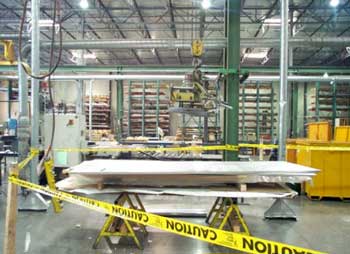 |
|
Exhibit #1. The work area where the incident took place.
|
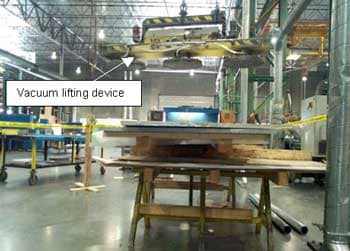 |
|
Exhibit #2. The three-cup vacuum lifting device suspended above the aluminum plates.
|
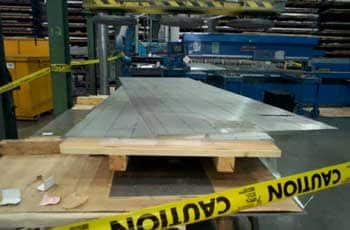 |
|
Exhibit #3. The aluminum plates involved in the incident.
|
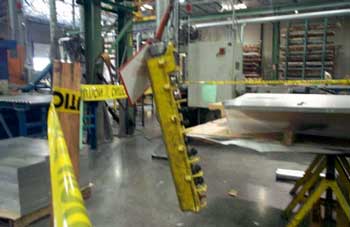 |
|
Exhibit #4. The crane controls.
|
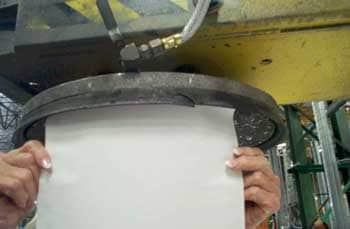 |
|
Exhibit #5. The damaged suction cup.
|
Reference
- California Code of Regulations, Vol. 9, Title 8, Sections 4896, 5002, 5009
California Fatality Assessment and Control Evaluation (FACE) Project
The California Department of Health Services, in cooperation with the California Public Health Institute, and the National Institute for Occupational Safety and Health (NIOSH), conducts investigations on work-related fatalities. The goal of this program, known as the California Fatality Assessment and Control Evaluation (CA/FACE), is to prevent fatal work injuries in the future. CA/FACE aims to achieve this goal by studying the work environment, the worker, the task the worker was performing, the tools the worker was using, the energy exchange resulting in fatal injury, and the role of management in controlling how these factors interact. NIOSH funded, state-based FACE programs include: Alaska, California, Iowa, Kentucky, Massachusetts, Michigan, Minnesota, Nebraska, New Jersey, New York, Oklahoma, Oregon, Washington, West Virginia, and Wisconsin.
To contact California State FACE program personnel regarding State-based FACE reports, please use information listed on the Contact Sheet on the NIOSH FACE website. Please contact In-house FACE program personnel regarding In-house FACE reports and to gain assistance when State-FACE program personnel cannot be reached.
